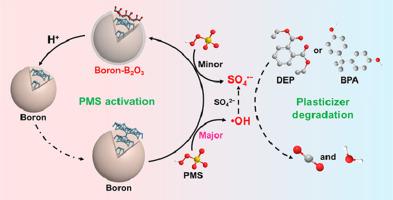Water Research ( IF 11.4 ) Pub Date : 2020-08-31 , DOI: 10.1016/j.watres.2020.116361 Wei Ren 1 , Peng Zhou 2 , Gang Nie 1 , Cheng Cheng 3 , Xiaoguang Duan 4 , Hui Zhang 3 , Shaobin Wang 4

|
Plasticizer pollution in drinking water and aquatic systems has raised global concerns due to the lasting and chronic hazards to marine life and public health. Metal-free materials are promising as green catalysts for wastewater purification. In this study, amorphous boron was applied as a metal-free activator to decompose peroxymonosulfate (PMS) for the degradation of plasticizers in water. Integrating radical trapping and selectively quenching tests with kinetic evaluation and electrochemical analysis, hydroxyl radical was found to be the dominating reactive oxygen species (ROS). With a strong oxidative capacity, the boron/PMS system can effectively degrade both bisphenols and phthalates plasticizers. In contrast, a carbon nanotube-catalyzed PMS system mediated a nonradical pathway to oxidize the electron-rich plasticizer (bisphenol A), but ineffectively to decompose the highly recalcitrant phthalates plasticizers (diethyl phthalate). Moreover, we unveiled that the boron surface was oxidized to boron oxide during the redox reaction, and the oxide would be self-cleaned in the acidic solution to regenerate fresh boron and restore the activity during the cyclic operations. Therefore, this work not only gains new insights into the radical and nonradical oxidations by metal-free catalysis, but also provides feasible technologies for plasticizer purification in water.
中文翻译:

羟基自由基在无金属硼上过氧单硫酸盐的消除增塑剂作用:动力学和机理。
由于对海洋生物和公共健康的持久和长期危害,饮用水和水生系统中的增塑剂污染引起了全球关注。无金属材料有望用作废水净化的绿色催化剂。在这项研究中,非晶态硼被用作无金属的活化剂,以分解过氧单硫酸盐(PMS)降解水中的增塑剂。将自由基捕获和选择性淬灭测试与动力学评估和电化学分析相结合,发现羟基自由基是主要的活性氧(ROS)。硼/ PMS系统具有很强的氧化能力,可以有效降解双酚和邻苯二甲酸酯类增塑剂。相比之下,碳纳米管催化的PMS系统介导了非自由基途径来氧化富电子增塑剂(双酚A),但不能有效分解高难降解的邻苯二甲酸酯增塑剂(邻苯二甲酸二乙酯)。此外,我们揭示了氧化还原反应期间硼表面被氧化成氧化硼,并且该氧化物将在酸性溶液中自清洁,从而再生新鲜的硼并在循环操作中恢复活性。因此,这项工作不仅对无金属催化的自由基和非自由基氧化有新的认识,而且为水中增塑剂的纯化提供了可行的技术。氧化物将在酸性溶液中自清洁,以再生新鲜的硼并在循环操作过程中恢复活性。因此,这项工作不仅对无金属催化的自由基和非自由基氧化有新的认识,而且为水中增塑剂的纯化提供了可行的技术。氧化物将在酸性溶液中自清洁,以再生新鲜的硼并在循环操作过程中恢复活性。因此,这项工作不仅对无金属催化的自由基和非自由基氧化有新的认识,而且为水中增塑剂的纯化提供了可行的技术。











































 京公网安备 11010802027423号
京公网安备 11010802027423号